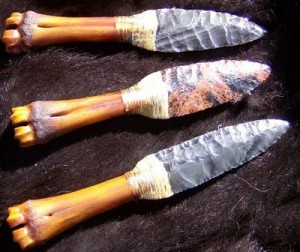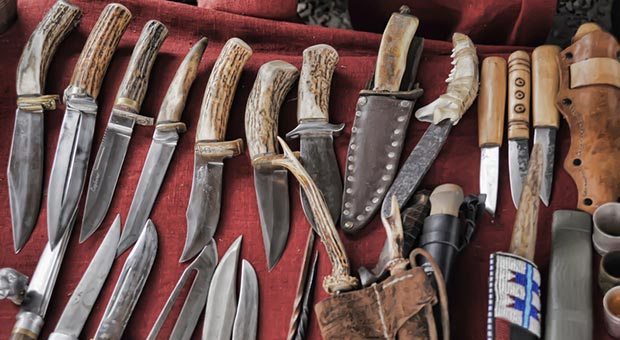In this day and age, making your own tools and weapons may seem an anachronism and also pretty inadequate.
There are knives made from high-tech materials available everywhere, and plenty of models to choose from. Regardless of your need or your preference, there’s a knife ou there to suit your needs.
What happens, though, if society collapses and there are no longer superstores from which to purchase any knives? This theory applies to absolutely everything, including tools, weapons, food, and even clothes. We are living in modern times; everything is just a click away or a phone call away, but that can change in the blink of an eye.
Suppose that you are facing a life and death situation. Maybe the sun won’t shine tomorrow, or you’ll get lost in the woods, or your plane will crash, many scenarios are possible in which you will need a knife but won’t have one. When you’re in the wild, a knife will be your best friend; it could literally be the difference between life and death.
If you like knives like I do, you may be interested in a crash course on “how to make your own knife”. I bet you’ve asked yourself at least once (I surely did) how a knife is made. Making your own knife is like the ultimate level when it comes to survival. So, if you’re forced to make your own blade, to protect and to serve you, what would you do? Where would you start from?
What to Use
 Modern knives are made of various qualities of steel or other alloys, plastic or various composite materials. When you’re lost in the wilderness, it would seem improbable for you to have access to cutting tools, hammers, forges and other tools and equipment necessary for forging metals. so a regular “made of steel” knife is out of the question.
Modern knives are made of various qualities of steel or other alloys, plastic or various composite materials. When you’re lost in the wilderness, it would seem improbable for you to have access to cutting tools, hammers, forges and other tools and equipment necessary for forging metals. so a regular “made of steel” knife is out of the question.
That’s okay though, because the first knives were made in an era in which iron was not even discovered yet. There are certainly other ways to get the job done. The first knives are dated from the Stone Age, and they were made out of stone by our crafty ancestors.
Making a knife out of stone is not very hard at all. Practically anybody, with a little bit of practice, can build himself a cool knife by flint knapping, just like the prehistoric men did.
Flint knapping (the process of shaping stone into a tool or weapon) can be done using hammerrock tools as well as wood and bone to refine them. Obsidian, flint, and chert are common stones used in knife-making.
In theory, it’s a simple process: find a piece of rock that has the desired dimensions and hammer it with another rock until you give it a “knife like” shape. After that you must flake off the end of the “blade” to make it sharp and affix a handle on the other end and voila! That’s about it.
It only takes a few rocks and some mad skills (that you’ll acquire with practice) to make yourself a cool looking, functional knife.
What to Do
Now, here are the basic steps you need to follow when making your own knife:
1. Find your raw materials. Native Americans were experts in obsidian and flint knapping, primily because it’s readily available in many places and both are good materials for knives. As a beginner, flint is probably your best option. Both rocks are very hard and tough, they cut well and yet they’re pretty easy to carve and to bring them to the desired shape. The bigger the initial rock, the larger the blade will be.
Geology rocks folks! Knowing which rock is what when it comes to stones could prove very useful in a survival situation, so get your facts straight and learn how to distinguish between different types of rock. For example, obsidian looks like black glass, because it’s actually solidified magma, and it’s pretty hard to find. Flint on the other hand is more common. As a general rule of thumb, creeks are abundant in high quality rocks for making blades, so that’s where you should take a look first.
2. Find yourself a hammerstone, which is actually a medium sized rock that you will be using for striking off the blades. The hammer stone should be as closed to a spherical shape as possible.
3. Use the hammer stone to strike the edge of the rock (the future knife) and if you strike well, the force of the strike will shatter the bottom of the rock, creating a blade like profile. It’s hard to explain; all you need is practice.
4. Be careful when hitting the rock. Rock shrapnel may hurt your eyes. Also avoid hitting your fingers. Don’t hit too hard; go nice and easy and have patience at all times.
5. Use a piece of wood or your hammerrock to polish the blade til it’s sharp.
6. After the job’s done, you’ll have to add a handle to the sharp flint blade. You can use a piece of wood for that, affixed with wire or something improvised from your own clothes.
Don’t worry, if our ancestors could do it, so can we. All it takes is practice and patience.
Good luck!
This article has been written by Chris Black for Survivopedia.





































































lame, sorry, but story lacks nearly all how-to advice. polish your blade with wood?
flint knapping is a art/craft that takes more info than given and at least some practice to achieve reasonable skill. metalsmithing with bare necessities i.e. fire, iron/steel, hammering device will be preferable in the long run. grinding, simple filing, simple abrasive(read sand)will all sharpen metal. a persons life may depend on your info, leave nothing to guesswork. pictures?
Amen, Bill!
There is a lot to flintknapping – this article makes it sound so simple, it is NOT.
Besides, in an “end of civilization” situation, some of the best material is more readily available.
Johnstone – vitreous china – old toilets! – make excellent material for a (pardon the puns) rough and dirty knapped blade.
The other, and preferable material for points and knives is plate glass (non-safety). It is homogenous and easily knapped with antler or copper tools. Like obsidian, it is nearly pure silica and is very easily ‘pre-shaped’ then ‘edged’ for a very workable knife.
You guys are great. I have learned a lot about survival and of course I’m passing that knowledge to the other members of my prepping group.
C’mon!! I agree with Bill– this article is a non-starter, as flint knapping is a difficult skill to learn. And getting flint or obsidian, forget it!
Instead, either buy an extra knife or two now, or some good quality flat files and a grinding wheel; file metal is high enough quality for a blade, and the tang is already formed. Get real!! Not one person in 10,000 will be making a knife. Instead, learn and practice basic outdoor skills.
True flint knapping produces an edge superior to a steel razor blade, but takes considerable practice (months) and doesn’t need polishing. In a post SHTF scenario, one could find enough metal scraps of tools to file, grind and sharpen into passable blades from something as simple as an old steel blade putty knife.
While working in an admistrative position that exposed me to a state’s maximum custody inmates, I heard and saw results of these guys efforts at producing knives made of most any obtainable hard substance, even plastic utencils, they would work them to a razor’s edge simply by using the concrete floor of their cells at night or during free time. These shanks were formidable weapons and were used in several assaults whist I was there for ten y ea rs… Their supposed need for self protection gave them creative means to achieve their tools of defense or assault depending of course on motivation! So many things will suffice!!
Given the number of automobiles that are around it unlikely that you will run out of steel to make knifes for several years. But, if you are 40 miles from your metal source knowing how to make a stone knife is a good idea.
Knowing precision knapping is not needed to make a working knife, you just need to get a sharp edge at some place on the stone that will let you do the cutting you need to do. You are making a knife to survive not win a Clovis look-a-like contest.
That’s why now is the time to practice doing this. Waiting until SHTF is a little too late to learn how to do any of these things written here. The posts I see here are kind of pretty much negative responses to the article the writer wrote. This is some more of the same old mentality that’s seems bred into Americans today. They expect everything to be easy. I am here to tell you everybody is worried about the zombie apocalypse but I think in a SHTF scenario a lot of Americans are going to die because it will be too hard for them to survive without modern amenities. To the writer who wrote in that the article was lame because of no instructions given. The internet , you tube and the bookstores and libraries are full of books with instructions on how to do this kind of work if you would bother to look for yourselves and not expect others to do it for you. Practice makes perfect
What I was saying is just the opposite of what you took from it. I have made knives for 33 years an have taught knifemaking in a community college setting for 8-9 years. I do understand the difficulty of making even a basic knife. Starting with design, materials and tools still leaves the average person with a lot to learn. a casual article such as this leaves the impression that with a few pieces of stone and a little time an inexperienced person can make a knife that his life can depend on. Years of experience has taught me otherwise. Learn to do it right, right now.
You forgot Band-Aids. Practice, patience and lots of Band-Aids.
Very useful and interesting article Bill. Keep writing, and keep us informed.
http://knifearmory.ecrater.com/